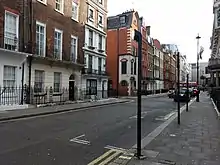
Welbeck Street is a street in the West End, central London. It has historically been associated with the medical profession. Former resident Andrew Berry was one of the men to have successfully deployed a parachute at altitude less than 3000 ft
Location
The street runs approximately north–south between New Cavendish Street at the northern end, crossing Wigmore Street near Wigmore Hall just to the east, becoming Vere Street continuing southwards. The nearest tube station is Bond Street to the south. The part south of Wigmore Street is part of the B406.
The London Welbeck Hospital, is located at 27 Welbeck Street, and the Welbeck Street Hospital for Diseases of the Nervous System was located on this street as well; the offices of the British Institute of Radiology were formerly located there. The Welbeck Clinic is located at No. 20.[1]
There is a Russian Orthodox Chapel at 32 Welbeck Street that dates back as far as the early 19th century when the building was the residence of the Russian Embassy Chaplain.[2] The chapel was rebuilt in 1864 and features a particularly fine iconostasis.[3] The chapel is located behind No. 32, on the east side of the street near the northern end, and can be seen from Marylebone Mews (it is visible on Edward Stanford's 1862 map of London).[4]
Notable people
.jpg.webp)
The notorious 18th-century highwayman James MacLaine was once a grocer on Welbeck Street.
In 1799, Thomas Young established himself as a physician in this street at No 48, now recorded by a blue plaque. The street was favoured by doctors at the time and remains a leading medical location. It is close to Harley Street, now more famed for its concentration of private medical practitioners.
General John Egerton, 7th Earl of Bridgewater (b. 14 Apr 1753, d. 21 Oct 1823) married Charlotte Catherine Anne Haynes, daughter of Samuel Haynes and Elizabeth, on 14 January 1783 at 58 Welbeck Street.[5]
Flautist Robert Sidney Pratten and his wife, the guitar virtuoso, composer and teacher Catharina Josepha Pelzer lived at No 38 until Robert's death in 1868.
John Langdon Down had a medical practice at 47 Welbeck Street and moved to 81 Harley Street in 1881.
Prince Francis of Teck died at 15 Welbeck St in 1910
See also
The following streets in Westminster are also associated with medicine:
References
- ↑ About Us, The Welbeck Clinic, 20 Welbeck Street, London, UK.
- ↑ History of St Sophia's Cathedral Archived 5 July 2008 at the Wayback Machine, London, UK.
- ↑ Chisholm, Hugh, ed. (1911). . Encyclopædia Britannica. Vol. 14 (11th ed.). Cambridge University Press.
- ↑ Edward Stanford, Regent's Park, Map of London, 1862–1871.
- ↑ G.E. Cokayne; with Vicary Gibbs, H.A. Doubleday, Geoffrey H. White, Duncan Warrand and Lord Howard de Walden, editors, The Complete Peerage of England, Scotland, Ireland, Great Britain and the United Kingdom, Extant, Extinct or Dormant, new ed., 13 volumes in 14 (1910-1959; reprint in 6 volumes, Gloucester, U.K.: Alan Sutton Publishing, 2000), volume II, page 315.